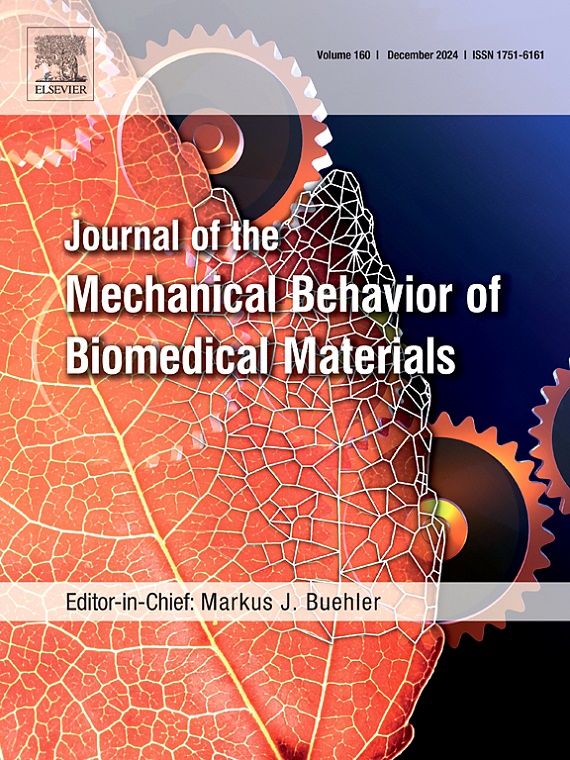A 3D generative structural model of trabecular bone using a novel probabilistic approach
IF 3.3
2区 医学
Q2 ENGINEERING, BIOMEDICAL
Journal of the Mechanical Behavior of Biomedical Materials
Pub Date : 2025-07-04
DOI:10.1016/j.jmbbm.2025.107118
引用次数: 0
Abstract
This study aims to develop a three-dimensional (3D) generative trabecular bone model capable of rendering digital models that closely resemble real trabecular bone microstructures. This model was constructed based on a previously proposed probability-based framework, integrating image processing, Voronoi tessellation, inverse Monte Carlo simulation, and computer graphics techniques. To evaluate its efficacy, the microstructural and mechanical properties of the synthesized digital models were compared with those of target real bone samples in pairs. The target real bone samples consisted of a total of 542 trabecular cubes, extracted from different anatomical locations of six human cadaver proximal femurs of different ages and sexes. A set of scalar and random variables defining the microstructural features were measured from the target real bone samples and used as inputs for the generative model to synthesize digital models. The results demonstrated that: (1) The microstructural features of the synthesized digital models closely matched those of the target real bone samples in terms of trabecular orientation, size, and spatial arrangement, with mean Hellinger Distance ranging from 0.051 to 0.187. (2) The synthesized digital models captured the histomorphometric parameters of the target real bone samples in terms of BV/TV, PN, RN, R-P Junc.D, R-R Junc.D, and P-P Junc.D. (3) The digital models effectively captured the anisotropic mechanical behavior of the target real bone samples, with R2 values ranging from 0.93 to 0.97 for the stiffness tensor and 0.90 to 0.93 for yield stress. These findings confirm the proposed generative model's efficacy in mimicking the microstructural and mechanical properties of trabecular bone.
使用一种新的概率方法的骨小梁三维生成结构模型
本研究旨在开发一种三维(3D)生成骨小梁模型,能够绘制与真实骨小梁微结构非常相似的数字模型。该模型是基于先前提出的基于概率的框架构建的,集成了图像处理、Voronoi镶嵌、逆蒙特卡罗模拟和计算机图形学技术。为了评估其有效性,将合成的数字模型与目标真实骨样品的显微结构和力学性能进行了成对比较。目标真实骨样本由542个骨小梁立方体组成,从不同年龄和性别的6具尸体近端股骨的不同解剖位置提取。从目标真实骨样本中测量一组定义微观结构特征的标量和随机变量,并将其作为生成模型的输入来合成数字模型。结果表明:(1)合成的数字模型在骨小梁取向、大小和空间排列等方面与目标真实骨样品的显微结构特征非常接近,平均Hellinger Distance在0.051 ~ 0.187之间。(2)合成的数字模型以BV/TV、PN、RN、R-P Junc为指标捕获目标真骨样品的组织形态学参数。D, R-R - Junc。D, P-P。(3)数字模型有效地捕获了目标实骨样品的各向异性力学行为,刚度张量的R2值在0.93 ~ 0.97之间,屈服应力的R2值在0.90 ~ 0.93之间。这些发现证实了所提出的生成模型在模拟小梁骨的微观结构和力学特性方面的有效性。
本文章由计算机程序翻译,如有差异,请以英文原文为准。
求助全文
约1分钟内获得全文
求助全文
来源期刊

Journal of the Mechanical Behavior of Biomedical Materials
工程技术-材料科学:生物材料
CiteScore
7.20
自引率
7.70%
发文量
505
审稿时长
46 days
期刊介绍:
The Journal of the Mechanical Behavior of Biomedical Materials is concerned with the mechanical deformation, damage and failure under applied forces, of biological material (at the tissue, cellular and molecular levels) and of biomaterials, i.e. those materials which are designed to mimic or replace biological materials.
The primary focus of the journal is the synthesis of materials science, biology, and medical and dental science. Reports of fundamental scientific investigations are welcome, as are articles concerned with the practical application of materials in medical devices. Both experimental and theoretical work is of interest; theoretical papers will normally include comparison of predictions with experimental data, though we recognize that this may not always be appropriate. The journal also publishes technical notes concerned with emerging experimental or theoretical techniques, letters to the editor and, by invitation, review articles and papers describing existing techniques for the benefit of an interdisciplinary readership.
 求助内容:
求助内容: 应助结果提醒方式:
应助结果提醒方式:


